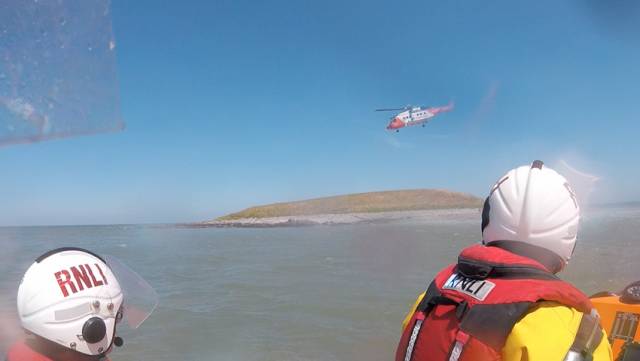#RNLI - Skerries RNLI launched yesterday afternoon (Tuesday 3 July) shortly after 1.30pm after a motorboat with two on board called the coastguard via VHF radio to report they were taking on water near Rockabill Lighthouse.
The lifeboat was launched with volunteer Philip Ferguson at the helm and Emma Wilson and Joe May as crew, ensuring that they had loaded the salvage pump aboard.
They proceeded in the direction of Rockabill and quickly had the stricken boat in sight. Once on scene, they transferred the salvage pump and began pumping water from the boat as they continued to head towards Skerries Harbour.
Dublin’s Irish Coast Guard helicopter Rescue 116 had also been tasked and was soon on scene and standing by.
There was a concern that the salvage pump being used may run out of fuel before the casualty reached Skerries. After communications with the helicopter, it was decided to transfer an additional pump.
The safest method of doing this in the prevailing conditions was to transfer the pump, along with a winchman, to Colt Island, where the lifeboat then picked it up and brought it to the casualty.
Once both pumps were operational, the lifeboat and helicopter escorted the vessel to the safety of Skerries Harbour. Skerries Coast Guard then secured the Red Island landing site for Rescue 116 to touch down and recover their winchman.
The incident came less than 24 hours after the Skerries lifeboat was tasked to a kayaker struggling to get back on board his craft.
Lifeguards on the South Beach in Rush alerted the coastguard on Monday afternoon (2 July) that a kayaker had entered the water and appeared to be having difficulty getting back on board. Skerries RNLI were tasked and the volunteers launched their Atlantic 85 inshore lifeboat, with Joe May at the helm and crew Eoin Grimes and Sheila May.
As the lifeboat approached Rush beach, they liaised directly with lifeguards who were able to guide them directly to the casualty.
Just before the lifeboat arrived, the man had managed to get back on his kayak and had begun to make his way ashore. The lifeboat crew spoke to the man and he assured them that despite being tired, he was happy to make his own way ashore. He was met at the shoreline by the lifeguards who offered him assistance.
Speaking after both callouts, Skerries RNLI volunteer lifeboat press officer Gerry Canning said they were “a great example of how well the different organisations work together. It’s also showed the difference it can make having the right equipment, and making the call for help as early as possible.”
































































